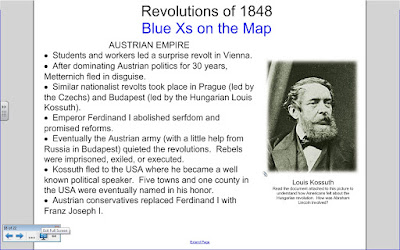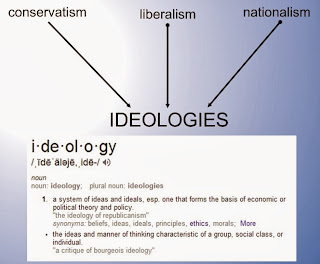Abraham Lincoln and Louis Kossuth in 1852... an example of an integrated history lesson
I am fortunate enough to be a participant in the final year of the History Connected program. This year is called American Encounters: U.S. History in a Global Context. Since our first school day seminar way back in October, there has been a lot of talk and interest in the integrated U.S. and world history curriculum here at Reading Memorial High School. We were even fortunate enough to have colleagues from Wilmington visit us a few weeks ago and sit in on some of our classes to observe the curriculum in action. It was refreshing to have the faces of enthusiastic professionals in our classes while we taught. As I look back to that October workshop and consider some of the documents that were discussed, a new great connection between world and U.S. history comes to mind.
Specifically, as we read through the Lincoln documents in an effort to get to know the man behind the myth, there were two that mentioned Louis Kossuth and the Hungarian Nationalist movement. In 1852, Lincoln was part of a call for a "Kossuth Meeting" and then helped run it and draft the resolutions from the actual meeting. These documents can help students understand what Americans at the time thought of the intense nationalism and fervor that was fueling the revolutions in Europe in 1848.
Some of the information presented to our sophomore students looks like this:
I added one element to make the connection between Kossuth and the U.S. (referenced in the 6th bullet) more clear. Under the image of Kossuth on the left, students are instructed to read the primary source documents that are attached. I have included a few excerpts within this post to illustrate what kind of information I would want students to notice in order to integrate U.S. and world history in this lesson.
The first excerpt is from January 5, 1852:
This is a very simple lesson tweak that can really help students understand how the world was interacting long before the Internet made it easy. Sometimes, these short additional documents and small lesson adjustments are all it takes to make an integrated curriculum work.
Specifically, as we read through the Lincoln documents in an effort to get to know the man behind the myth, there were two that mentioned Louis Kossuth and the Hungarian Nationalist movement. In 1852, Lincoln was part of a call for a "Kossuth Meeting" and then helped run it and draft the resolutions from the actual meeting. These documents can help students understand what Americans at the time thought of the intense nationalism and fervor that was fueling the revolutions in Europe in 1848.
Some of the information presented to our sophomore students looks like this:
I added one element to make the connection between Kossuth and the U.S. (referenced in the 6th bullet) more clear. Under the image of Kossuth on the left, students are instructed to read the primary source documents that are attached. I have included a few excerpts within this post to illustrate what kind of information I would want students to notice in order to integrate U.S. and world history in this lesson.
The first excerpt is from January 5, 1852:
It is proposed that a Kossuth meeting be held by the citizens and others now visiting the seat of government, on the 8th of January inst., at 7 o'clock P. M., at the court house in Springfield. All are invited to attend, and to express their views freely.Some questions for students to research and consider:
A. Lincoln, et. al.
- Why would Lincoln be one of the organizers of such a meeting?
- Did he hold any public office at the time?
- What does it say about his opinions of the revolutions of 1848?
7. That we recognize in Governor Kossuth of Hungary the most worthy and distinguished representative of the cause of civil and religious liberty on the continent of Europe. A cause for which he and his nation struggled until they were overwhelmed by the armed intervention of a foreign despot, in violation of the more sacred principles of the laws of nature and of nations---principles held dear by the friends of freedom everywhere, and more especially by the people of these United States.And then in the annotations, it is noted:
[1] Illinois Journal, January 12, 1852. Lincoln spoke to the meeting on the 8th in favor of sympathy but non-intervention.More questions for students to discuss:
- What principles does Lincoln seem to be emphasizing in his support of the Hungarians based on the resolution?
- Why would Lincoln stress non-intervention?
This is a very simple lesson tweak that can really help students understand how the world was interacting long before the Internet made it easy. Sometimes, these short additional documents and small lesson adjustments are all it takes to make an integrated curriculum work.



.jpg)
Whether you are a multi-location group that has centralized management needs or a small salon desiring to computerize as you get started, there are software solutions available to meet your needs as well as your future aspirations.STC Technologies
ReplyDelete